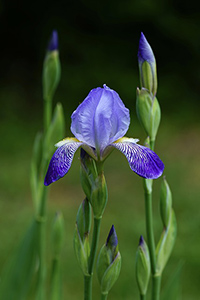Table of Contents
The great Greek physician, pharmacologist, botanist, and author Pedanius Dioscorides devoted a long paragraph in the first chapter of his De Materia Medica to the virtues of the iris plant. Andres de Laguna (16th century) translated Dioscorides’s works into Spanish and commented on them, remarking on their multiple properties, such as “wonderfully purging the brain when its juice is taken through the nose.” Some years later, the plant was forgotten; however, recently, its virtues have been extolled again.

Healing Properties and Indications
Its root contains 50 percent starch, mucilage, and a very aromatic essential oil that gives the plant its peculiar violet aroma. When fresh, the plant’s rhizome is a strong laxative but not so intense when dry. Due to its notable expectorant and antitussive properties, it is also used in several bronchial medicines. It is also a diuretic.
Iris Plant Scientific Facts

- Other names: Orris root.
- French: Iris, flambe
- Spanish: Lirio.
- Environment: It is native to southern Europe but naturalized on the whole continent. It is farmed throughout Europe and some American countries.
- Description: This is a vigorous plant of the Iridaceae family. It has a straight stem 50 to 80 cm high, at the tip of which grows attractive purple flowers. The rhizome is very thick.
- Parts of the plant used medicinally: The rhizome (underground stem) when dried.
How to use Iris
- Decoction with five to 20 g of dry rhizome powder per liter of water, boiling for ten minutes, then drinking two or three cups daily.

White Iris Plant
The white iris plant is another species of the botanical family. It is spread all along the Mediterranean coast and the Canary Islands, and its properties are similar to those of the common iris. Another variety of iris in Mediterranean areas is the pale iris (Iris pallida Lam.), whose flowers are light blue. The composition and properties of all three species are similar.
Frequently Asked Question
Which part of the plant is most often used medicinally?
The plant’s rhizome (underground stem) is the primary part of its potential health benefits. This is where the most active compounds are concentrated.
What are the traditional uses of iris rhizome?
Historically, the rhizome (typically from Iris germanica or Iris pallida) has been used in traditional medicine practices for:
1. Respiratory conditions (cough, bronchitis)
2. Digestive issues (constipation, liver problems)
3. Skin inflammation
4. Dental pain
Are there studies supporting the use of iris for health purposes?
While traditional use is extensive, scientific studies are limited. More research is needed to confirm potential benefits and understand long-term safety.
What are the potential active compounds in the iris?
The plant’s rhizomes contain several compounds believed to have health properties, including:
1. Iridin (an isoflavone)
2. Isoflavonoids
3. Triterpenoids
Has this plant been studied for its anti-inflammatory potential?
Limited evidence suggests potential anti-inflammatory properties of the plant’s compounds.
Does the plant have any antioxidant properties?
Preliminary research indicates that the plant’s extracts may have antioxidant activity, which could protect against cellular damage.
Are there possible side effects?
Iris rhizome, when used in excess quantity, can potentially cause:
1. Gastrointestinal irritation (nausea, vomiting)
2. Skin irritation in some individuals
Is iris safe for pregnant or breastfeeding women?
There is not enough reliable information on the safety of this plant during pregnancy or breastfeeding. It’s generally advised to avoid use.
Can the plant interact with any medications?
Due to limited research, potential interactions of the plant with medications are largely unknown. It’s best to consult a healthcare professional before using it with any medication.
Where can I find reliable information about using iris for health?
Always consult reputable sources and talk to your doctor before using this plant. Good resources include:
1. National Institutes of Health (NIH) https://nccih.nih.gov/
2. Your healthcare provider
DISCLAIMER: All content on this website is presented solely for educational and informational objectives. Do not rely on the information provided as a replacement for advice, diagnosis, or treatment from a qualified medical expert. If you are pregnant, nursing, or have any preexisting medical concerns, talk to your doctor before using any herbal or natural medicines.
REFERENCES
- George D. Pamplona-Roger, M.D. “Encyclopedia of Medicinal Plants.” George D. Pamplona-Roger, M.D. Encyclopedia of Medicinal Plants. Ed. Francesc X. Gelabert. Vols. 1 San Fernando de Henares: Editorial Safeliz, 2000. 315. Print.
- National Institutes of Health, National Center for Complementary & Integrative Health https://nccih.nih.gov/
- WebMD https://www.webmd.com/vitamins/ai/ingredientmono-735/orris
- Frontiers in Pharmacology https://www.frontiersin.org/articles/10.3389/fphar.2019.00507/full
